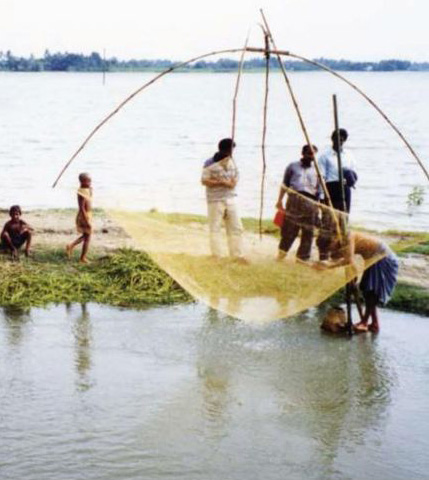Difference between revisions of "Finger pond"
(→Acknowledgements) |
|||
| Line 64: | Line 64: | ||
==Acknowledgements== | ==Acknowledgements== | ||
| + | * [http://www.ihe.nl/Fingerponds The Fingerponds Project]. UNESCO-IHE, 2005. | ||
Revision as of 21:58, 12 November 2012
Finger ponds use innovative techniques to enhance the natural productivity of wetlands and floodplains. The ponds (body of water smaller than a lake) consist of stretched artificial ponds 5 to 12 m long, extending into the wetland like fingers, hence the name. Finger ponds are excavated at the upstream edge of naturally occurring wetlands or floodplains and are lined with PVC plastic to prevent the water running out. They fill up during the flood cycle, and trap fish within them as the flooding recedes.
Fish are grown in the ponds during the dry season and can be caught to provide additional protein for local communities. The ponds can be enriched with manure. Meanwhile the land between the ponds is cultivated with seasonal crops. Pilot projects with finger ponds are being undertaken to assess their potential productivity, suitability and sustainability, taking into account natural and socio-economic aspects. Water that otherwise would run off or evaporate is now stored in these finger ponds during the dry periods. The annual inundation provides opportunities for aquaculture, fish cultivation and small-scale crop cultivation through irrigation.
Contents
Suitable conditions
- Wetlands or floodplains where water collects naturally.
- The local morphological situation dictates the specific requirements, costs and time needed for excavating the ponds.
| Advantages | Disadvantages |
|---|---|
| - Allows fish cultivation - Provides additional protein |
|
Construction, operations and maintenance
- Maintenance consists of cleaning or desilting the ponds by swabbing the pond bottom.
Costs
Depending on local situation and size of the ponds.
Field experiences
In 2005, a study of finger ponds by The Riparian people of East Africa aimed to:
- Establish criteria for optimal fish yields
- Assess socio-economic benefits and
- Develop and leave for use a practical, fish production tool with guidelines.
The study
Fingerponds will be located in 6 villages, distributed in three countries (Uganda, Kenya and Tanzania, 2 villages in each country) in order to assess fish yields under a range of sociological and environmental conditions. Within each village, we will test the effects of additional fringe vegetation and manure addition in a full factorial design, yielding a total of 24 ponds.
Controlled fishing through the dry season will supply protein for the village people and for trade. Fingerpond construction, cultivation, security, care and maintenance, and records of fish catches, harvests, fertiliser additions, general husbandry and marketing will be co-managed by villagers who will receive training and supervision.
The 4-year research programme (i) evaluates the systems for potential development within "wetland wise-use" strategies, and (ii) aims at understanding the ecological processes that govern production in fingerpond systems.
The project includes studies on water and nutrient balances, food webs isolated in the ponds, fish yield and possibilities to optimise them, models to assess the sustainability and productivity of the food webs and socio-economic costs and benefits.
We will test the following hypotheses:
- Fingerponds enhance the fisheries potential of wetlands to the benefit of local people;
- The flood cycles substantially affect fish yields;
- Addition of manure and
- Increasing the vegation/water interface zones increases fish yields;
- Associated seasonal raised-bed agriculture for food production is cost-beneficial.
For more information on the Fingerponds Project: see UNESCO-IHE website.
Manuals, videos, and links
Acknowledgements
- The Fingerponds Project. UNESCO-IHE, 2005.

